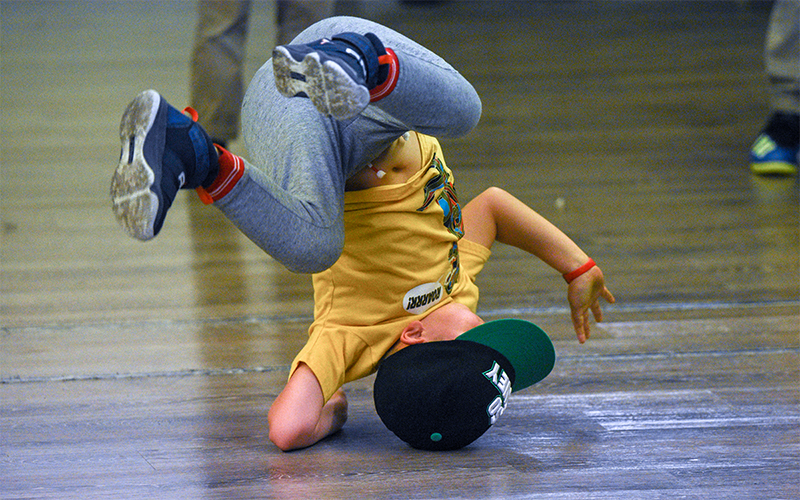Breakdancing, common injuries and prevention.

Breaking It is a dance with spectacular and challenging sports movements that combines strength, endurance, flexibility and creativity.
However, like any intense physical activity, it carries a risk of injury. For Bboys and Bgirls, preventing injuries is key to staying active and progressing smoothly, especially for younger children who have less control and body awareness.
Most common injuries in breakdancing
1. Sprains and strains
Quick movements, changes in direction, and bad falls can cause sprains in ankles, wrists, and knees.
Prevention:
- Perform a proper warm-up before training.
- Strengthen ligaments and muscles with specific exercises.
- Use elastic bandages or wristbands if necessary.
2. Wrist injuries
The wrists bear a lot of the weight in freezes and power moves, which can cause tendonitis, sprains, or simply an open wrist.
Prevention:
- Strengthen your wrists with resistance and mobility exercises.
- Take adequate breaks between workouts.
- Use wristbands to reduce pressure on the joint.
3. Blows to the head
Moves like headspins, head freezes, or the windmill can cause bruises or burns if not executed correctly.
Prevention:
- Practice on mats or padded surfaces at first.
- Use protective equipment such as wool hats or special caps for breaking dance.
- Improve technique progressively and under supervision.
4. Pain in the knees
Floor work (footwork, drops, slides) can affect the knees, causing pain, inflammation and burns.
Prevention:
- Strengthen the muscles surrounding the knee.
- Avoid training on unprotected hard surfaces.
- Wear knee pads for high-impact movements. Highly recommended.
5. Back injuries
Explosive movements such as backflips, monkeys or windmills can overload the lower back.
Prevention:
- Do core strengthening exercises.
- Practice progressions before attempting advanced moves.
- Maintain good posture and technique in every movement.
6. Fractures and dislocations
Failed attempts at moves like flares or airflares can lead to fractures or dislocations from bad landings.
Prevention:
- Learn the technique correctly before trying advanced movements by doing many preliminary exercises.
- Do not force your body if it is not ready.
- Having supervision from an experienced trainer or someone who has mastered the movements is always the best option.
General tips to prevent injuries
- Proper warm-up
Performing a 10-15 minute warm-up before any breakdancing session is essential to properly prepare your body. Warming up increases blood circulation to the muscles and improves flexibility, which is vital to avoiding injuries during the intense movements involved in this discipline.
Your warm-up should include low-impact exercises that mobilize all major joints and muscles, such as ankle, wrist, and shoulder rotations, and dynamic stretches that involve your legs, back, and neck.
In addition, a good warm-up helps prepare the mind, improving concentration and reducing the anxiety that training or competition can generate.
- Muscle strengthening
Strength and stability exercises are essential for protecting joints and preventing injuries. Breakdancing involves a large number of explosive, high-impact movements, so it's important to work on strengthening the most vulnerable areas, such as the shoulders, wrists, hips, knees, and core.
Incorporating exercises like push-ups, sit-ups, planks, and squats not only helps improve muscle strength but also joint stability. Weights or resistance bands can be a useful tool to add resistance and improve overall muscle strength.
Additionally, performing core stability training, such as balance exercises, helps prevent falls and injuries to the lower back and torso. Strong, stable muscles allow dancers to have greater control over their movements, reducing the risk of injury and improving overall performance.
- Gradual progression
One of the keys to avoiding injuries and achieving optimal performance in breakdancing is to follow a gradual progression. Don't attempt advanced moves without first mastering the basics.
Breaking is a discipline that requires a lot of technique and body control, so skipping the basic steps can result in serious injuries.
Progression should be fluid and based on your skills, moving on only when you feel confident you've mastered the previous step. Remember that the path to success in any discipline isn't a race, but rather a series of steps that must be followed sequentially.
As in math, you must first learn to add and subtract before you can multiply and divide.
- Stretching and resting
Post-workout stretching is essential for muscle recovery and to prevent stiffness after an intense breaking session.
This not only helps improve flexibility, but also reduces the risk of muscle and joint injuries by keeping the muscles long and relaxed.
A good rest plan may also include getting enough sleep to allow muscles to recover properly, and in some cases, using techniques such as massage or cold therapy to reduce inflammation.
- Listen to the body
Listening to your body is crucial for preventing common breakdancing injuries. If you feel pain or discomfort during a practice or movement, it's essential to stop and take a break. Forcing an injury or continuing to train when you're experiencing discomfort can worsen the injury and prolong recovery time.
Breaking is a demanding discipline, and sometimes the desire to progress can cause us to ignore our body's signals, but ignoring them only leads to negative consequences. It's important to be aware of your body's limitations and give it the time it needs to heal when necessary.
Remember that recovery is just as important as the training itself to keep your body in optimal condition and avoid long-term injuries. Listening to your body will allow you to practice more safely and sustainably over time.
Conclusion
By following these tips, you'll improve your performance and stay on the dance floor for much longer. If you enjoyed this article about breakdancing, common injuries, and prevention, you can learn many more interesting things in this article. artículo!
If you found this article helpful, please share it with other dancers so they can stay safe while training too! 🌟